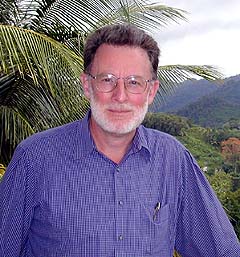|
the Journal of the Hyperlinked Organization (JOHO) A former TV cameraman, freelance photographer, and software company president, in 1992, Jock Gill joined the campaign of his friend Bill Clinton, and then went to work as a "technology wonk" in the communications department at the White House. After two years advising the administration on Internet issues, he left to become a consultant to companies ranging from startups to IBM, John Hancock and General Motors. Jock continues to do volunteer work for political groups in Washington as well as maintain his corporate consulting activities.  In addition, he is a director of North Atlantic Telephone and of the Greenstar Foundation (http://www.greenstar.org), an international non-profit organization "committed to peace, economic development, quality medical care, and clean energy." David Weinberger interviewed him in his home city, Boston.
Q: Our electrical network is very much like pre-Web networks: centralized, over-engineered, with power dribbling out to the edges. How is that changing? A: There's a major design flaw in our current, centralized-grid solution to power generation and distribution: after 100 years, a third of the world's population still doesn't have power. If we don't get a better idea, 2 billion people will never be served. Think of this in terms of opportunity: we need to grow the market by 50% - from 4 billion to 6 billion -- and at the same time not destroy the natural systems which make life possible for us. That's the scale of the 'empowerment' opportunity. The solution is for the electrical network to take on the properties of the Web, especially decentralization. Houses should be self-powered -- each house should create its own electricity in one way or another.
Q: How? The most likely power source for a home will be a dishwasher-sized fuel cell in the basement cooperating, via IP protocols, with the fuel cell powering the family sedan and a few of its immediate neighbors. At first the fuel cell will most probably be charged by natural gas. Eventually it will be hydrogen derived from splitting water -- the reverse of what the fuel cell does: combine oxygen and hydrogen to create electricity and water.
Q: What about solar power? A: For those parts of the world where there's no natural gas distribution system, electricity from sunlight, photovoltaics [PV], is the best answer -- along with a mix of micro hydro turbines, wind and biomass as may be appropriate. This is why our Greenstar Village Centers ship with at least 2 kilowatts of PV capability. But whether it's solar or gas, the point is that everyone is abandoning, as fast as they can, solutions based upon centralized power plants with wire-based distribution networks.
Q: So, for a change, suburban America may find itself behind the curve as villages untouched by power lines, or telephone lines for that matter, use this technology and have electricity for the first time. A: Yes. When we started Greenstar in 1997, we were fascinated to learn that developing communities are much more free to adopt a decentralized power architecture than cities in the developed world. They don't have all those power poles, generators, coal- and oil-fired or nuclear plants, all that copper nervous system to pay for. They have no top-down legacy infrastructure to justify, investors to please or bonds to pay off, like the public utilities in America. So, for example, we're much more free to radically innovate in rural Palestine (which we've done recently) than we are in San Jose or Boston. We're creating new kinds of ever-smarter electrons.
Q: "Smart electrons"? A: It's not enough just turn on the lights and power a television with old-style dumb electrons. They only take wealth out of the village. We've tried these solar home projects and they just have not worked. Smart electrons, generated locally, distribute human intelligence -- telemedicine and distance learning for example -- by powering a computer, a modem, a digital wireless network. Now the village can create new wealth in new ways in larger markets, previously beyond their reach. Smart electrons -- power plus computing and communications technology plus training and support -- change economies by unleashing people's innate curiosity, intelligence and desire to communicate.
Q: And once villages are connected? A: We can build local and global e-commerce opportunities. It's only by dramatically enlarging the local village's usual trading zone that we can hope to increase the wealth in the village. Otherwise whatever we do only results in new products chasing the same supply of currency in the old trading area. With e-commerce we can enable local villagers to sell their goods -- say, fresh vegetables -- many tens of miles away because now we can communicate the information required to set up the markets and the transportation to serve them. Locally grown, non-perishable produce -- coffee, for example, or arts, crafts, music, books, stories, and so forth -- can be sold in the broader world e-market.
Q: Will connecting villages to the global village homogenize their cultures? Quite the contrary. Many international development programs in place now, as well-intentioned as they are, are flawed in a key respect: they presuppose that off-the-grid rural communities must develop into mini-clones of the developed world, in terms of their electrical, economic and telecommunications needs. We're trying to create distributed economic models, with an architecture akin to the Internet, that allow people to have more choices in all aspects of their lives; education, health, clean water, entertainment, for example, while strengthening their traditional communities and values.
Q: What could be the macro effect of these changes in village economies? A: For some commodities, such as coffee, we may see the type of direct, communications-driven selling the Web seems to favor. This could have an important effect on local and even world economies. Coffee , by the way, is the #2 commodity on the world market. (crude oil is #1). Today, many people who grow coffee have neither electricity nor communications. So, the macro effect could be a larger and more efficient market with a richer, more diverse, collection of items for sale. Additionally, this market would have a far greater level of participation and inclusion than the current industrial market which, given the limits of our current solution, ignores one third of the world's people. Is this necessary, ethical, or even a good idea?
Q: Come back to suburbia. With gridless power and the introduction of real competition, how will consumers decide? Price? Or value? A: As we become aware of the benefits of buying 'green' for our sake and the sake of the next seven generations, products with a green brand will command more attention in the market. Particularly as deregulated power suppliers in the wealthy economies seek to differentiate their products, we expect a 'green' branding point system to develop -- Greenstar has a number of ideas in this area -- which will create reward mechanisms for those of us who choose to buy green power rewards which can be redeemed in a variety of very interesting ways, products, services, and places!
Q: Not to change topics too suddenly, but how did you end up in the White House? A: As things worked out, a young woman I knew at college in the 60's, and whose roommate I married 30 years ago, was Hillary Rodham. Later, we got to know Bill. When you actually know a person running for the office of President, presidential politics takes on an unusually personal and powerful attraction. So I volunteered. One thing led to another.
Q: How truly does the Clinton administration "get" the Web? A: A good example of the depth of the Administration's understanding of the internet and its importance can be found in a very small change to an obscure law. When we came into office, the law of the land was that US government [USG] email must conform to the X.400 standard. X.400 systems were clumsy, non-interoperable, not backwards-compatible, as well as expensive. As a result, in January 1993 practically nobody in the USG had email, much less publicly accessible email. The administration simply expanded the definition of legal email standards options to include TCP/IP. And the rest is history -- as is X.400. Ever wonder why it died? The increase in the number of USG email accounts is dramatic, to say the least. In other words, it really does matter who is in Washington and setting the standards!
Q: I know you registered whitehouse.gov for the White House. But who lost whitehouse.com to the pornographers? A: I'll take the rap for that. Although I subsequently met the owner of that domain at an ICANN event at MIT and discovered we have one thing in common: a very healthy respect for the first amendment. Do I wish I had registered all whitehouse domain name combos? You bet! |
